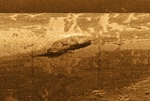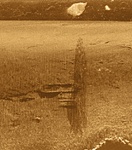Imaging the Depths of the Hudson River
by
Jim Kennard
October 6, 2010

Sonar image of an old schooner shipwrecked on the bottom of the Hudson River

Sonar image of the partial remains of an old shipwreck on the bottom of the Hudson River

Sonar image of the hull of an old Steamboat in the Hudson River. The dark "sonar "shadow across the right end of the hull is caused by a school of fish between the sonar sensor and the wreck that can be seen in the water column as a white blob.

Sonar image of the remains of the ribs of an old shipwreck in the Hudson River near Eves Point north of Saugerties.

Sonar image of a large rock outcrop near the ship channel in the Hudson River

Sonar image of scour marks made by ships or ice on the bottom of the Hudson River

Sonar image of the bottom beneath the Kingston-Rinecliff Bridge between two of the bridge uprights. The dark center area of the image with the GPS readings is the water column under the boat.

Sonar image of an old admiralty anchor partially buried in the bottom of the Hudson River.
Shipwreck explorers Jim Kennard and Dick Duncan recently conducted a search in the Hudson River near Saugerties, New York, using a very high resolution imaging sonar discovering seven abandoned shipwrecks within just a few hours.
Over 400 years ago Henry Hudson sailed his ship the Half Moon up the Hudson River. Since then hundreds of thousands of vessels have traversed this waterway including a variety of sailing ships, horse powered ferry boats, steamships, and gas powered boats. Some of the older sailing ships were eventually turned into barges to live out their usefulness. Many of the early ships and barges were used to the point where they were just not sea worthy any longer. These ships were then stripped of their fittings and any other items that could be reutilized elsewhere. Some were disassembled and removed completely from the river, while others were intentionally sunk and filled with stone creating a river break wall or used to create a new dock or extension to one that currently existed. A few of these lost ships are likely accidental sinkings and may still contain human remains. However, many of the vessels were just abandoned near shore or pushed into the river to find a resting place out of sight and into the depths of the Hudson. Years of continuous flow of river currents sometimes running with great force would cause a ship to come apart as its sides and ribs became loose and then fell away. Silt carried down the river would over time cause some of these abandoned ships to disappear completely only to be later uncovered by the changing currents.
Wooden ships do not disintegrate very quickly in the freshwaters of the Hudson River if they are not exposed to air and even less quickly if they are covered with silt. In salt water, wooden ships fall apart much faster because it accelerates the deterioration of iron fasteners and hastens the structural collapse of wooden boats. In addition, a shipworm, not found in freshwater, called the teredo bores holes in the wood, eventually causing a ship to all but disappear above the sea floor. Today, it is estimated that there may be more than 300 abandoned ships in various stages of deterioration from Albany to New York City. There are no reports of undiscovered ships filled with gold from Captain Kidd or other lost valuable cargos waiting to be found. The ships resting on the bottom of the Hudson are simply archaeological maritime treasures that span the development of river transportation for hundreds of years. Historic shipwrecks located on the underwater lands of the State of New York are protected under state and federal laws and should not be disturbed. The New York State Museum has the authority to issue permits for legitimate archaeological research. Removal of artifacts from these sites without such a permit is unlawful and diminishes the value of these sites for posterity.
The depths of the Hudson River have more to reveal than just shipwrecks, as there is a variety of interesting underwater geology. Pinnacles of rocky peaks, curious bedrock scourings and large sand waves are just a few of the hidden features in the river. Viewing geologic formations or shipwrecks by diving or by utilizing an underwater camera in the river is not feasible as the strong currents make navigating in these waters almost impossible. Contributing to the problem of underwater exploration is the heavy concentration of silt in the Hudson River that limits visibility to that of inches.
Recent developments of very high resolution sonar imaging systems now provide aerial photographic like images of the depths of lakes and rivers even in the murkiest conditions. These systems are similar to that of ultrasound used by medical doctors to observe unborn babies in the mother’s womb, but only on a larger scale. Known as side scan, or side looking sonar, the sensors are housed in a torpedo shaped body that is towed behind a boat. A continuous scan of the river bottom is saved on a laptop computer. To capture the high resolution images of the bottom of the Hudson River, Kennard utilized a side scan sonar system that had been recently developed by DeepVision, a company located in Sweden. This new sonar system is also capable of locating small objects and even human bodies depending upon the conditions on the bottom of a lake, river, or ocean.